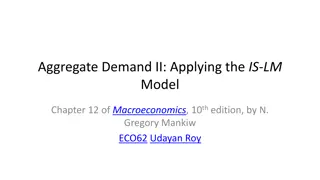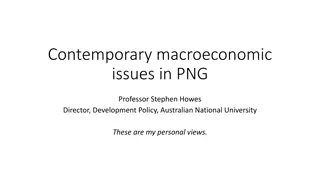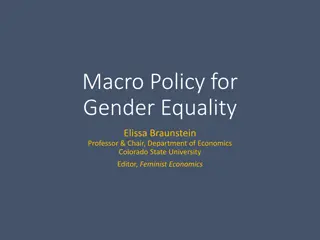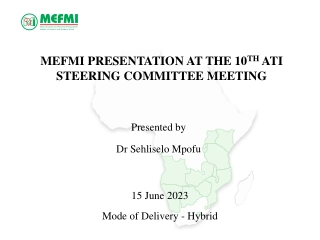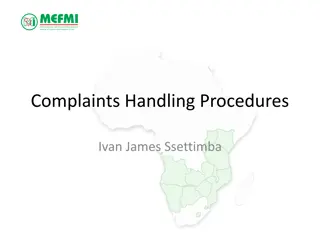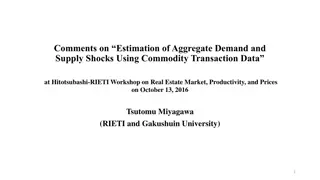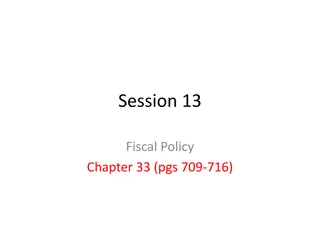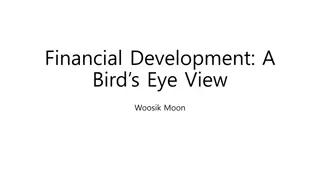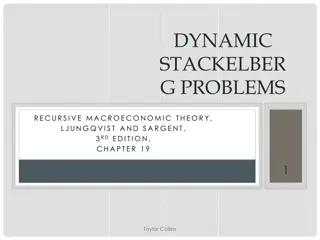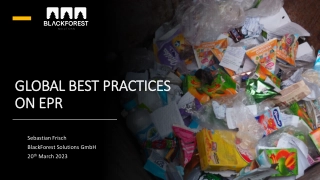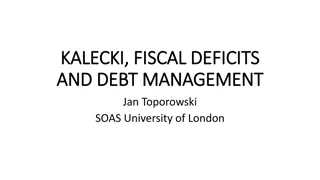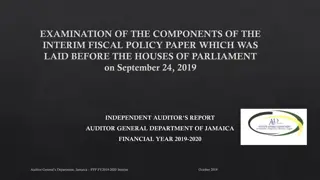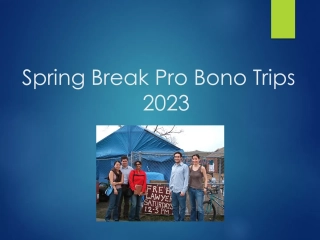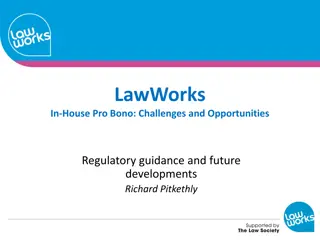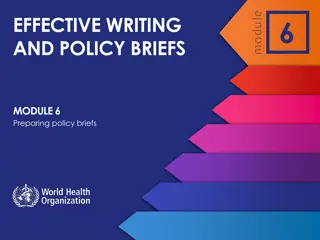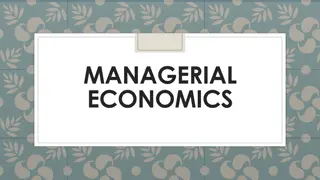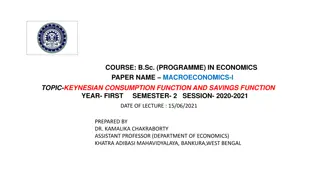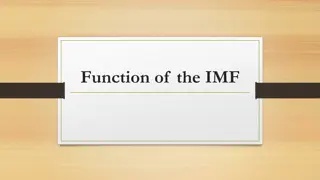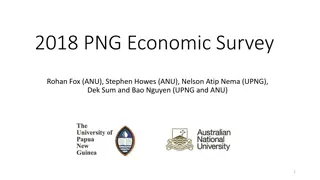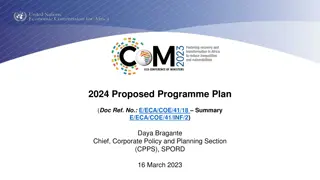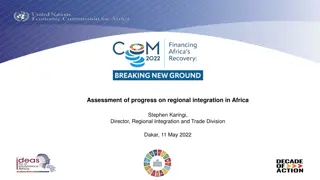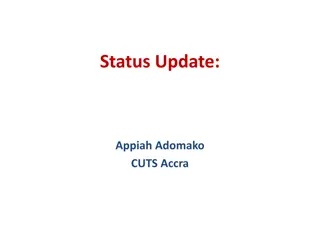Understanding Policy Pro-cyclicality in Macroeconomic Theory
Delve into the concept of policy pro-cyclicality in macroeconomic theory through the insights shared by Jeffrey Frankel at a seminar at Harvard Economics Department. Explore examples of pro-cyclicality in developing countries, euro periphery countries, and US political scenarios, along with discussions on fiscal counter-cyclicality, good institutions, and the impact on financial regulation. Gain an international perspective on fiscal counter-cyclicality, historical trends in government spending correlations, and the transition from pro-cyclical to counter-cyclical policies in various countries.
Download Presentation

Please find below an Image/Link to download the presentation.
The content on the website is provided AS IS for your information and personal use only. It may not be sold, licensed, or shared on other websites without obtaining consent from the author. Download presentation by click this link. If you encounter any issues during the download, it is possible that the publisher has removed the file from their server.
E N D
Presentation Transcript
Policy pro-cyclicality Macro Policy Seminar Harvard Economics Department, December 3, 2019 Jeffrey Frankel Harpel Professor of Capital Formation and Growth, Harvard Kennedy School Based on: (i) On Graduation from Fiscal Procyclicality, with V gh & Vuletin; J.Dev.Ec., 2013. (ii) The Next Economic Crisis, AEI Retreat, Jackson Hole, Aug. 2018.
Policy pro-cyclicality: Introduction People don t see the need to fix the hole in the roof when the sun is shining. They may see the mistake when the storm hits, but then it is too late. Admittedly it is hard to get counter-cyclical timing right; but that is no excuse for pro-cyclical policy. Three cases of pro-cyclicality: i) Developing countries, 1960-1999. ii) Euro periphery countries, 2000-2018. iii) US politicians of a particular party, esp. 2018. 2
Policy Pro-cyclicality I) International perspective : 1. Which countries are fiscally counter-cyclical? 2. Those with good institutions. 3. What specific institutions? Not rules. The problem is official forecasts. II) Claim: US Republicans act pro-cyclically, 1. with respect to fiscal policy, 2. but also monetary policy 3. and financial regulation. III) Question: Do I need to re-think this, now that some Democrats support fiscal & monetary expansion when unemployment 3 %? IV) Appendix: Elaboration on financial regulation V) Appendix: What specific institutions prevent fiscal pro-cyclicality? 1. Not fiscal rules. 2. The problem is optimism bias in official forecasts. 3. Chile s fiscal institutions: Insulate official forecasts against political pressure. 3
I) An international perspective: 1. Which countries are fiscally counter-cyclical? In the past, commodity-exporting developing countries were the most pro-cyclical Literature: Cuddington (1989), Gavin & Perotti (1997), Tornell & Lane (1999), Kaminsky, Reinhart & Vegh (2004), Talvi & V gh (2005), Mendoza & Oviedo (2006), Alesina, Campante & Tabellini(2008), Ilzetski & Vegh (2008), Medas & Zakharova (2009), Medina (2010), Arezki, Hamilton & Kazimov (2011), Erbil (2011), Avellan & Vuletin (2015), Vegh & Vuletin (2015). But many achieved counter-cyclicality after 2000. J.Frankel, Carlos V gh & Guillermo Vuletin (2013) Luis Felipe C spedes & Andr s Velasco (2014). Meanwhile, some euro countries went from counter-cyclical to pro-cyclical. 4
Correlations between Gov.t Spending & GDP 1960-1999 Pro-cyclical Adapted from Kaminsky, Reinhart & V gh (2004) When it Rains, It Pours countercyclical G always used to be pro-cyclical for developing countries. 5
Correlations between Government spending & GDP 2000-2018 Updated from Frankel, V gh & Vuletin (JDE, 2013) Thanks to Jose Andree Camarena & Guillermo Vuletin, World Bank, October 2019 After 2000, about 1/4 developing countries switched to countercyclical fiscal policy: Negative correlation of G & GDP. Cyclical components of real GDP & real Government Spending are calculated by Hodrick-Prescott filter, using 6.25 as smoothing parameter & extracting the cyclical components from the series of the level.
2. Who achieves counter-cyclical fiscal policy? Countries with good institutions On Graduation from Fiscal Procyclicality, Frankel with V gh & Vuletin; J.Dev.Ec., 2013
3. What specific institutions help achieve fiscal counter-cyclicality? Not budget rules. Most are violated. They only worsen a fundamental problem: Optimism bias in official forecasts. Three cases: Developing countries forecast that booms will last indefinitely, obviating any need for discipline. Frankel (2011) and Frankel & Schreger (2016). Eurozone members forecast that growth next year will bring budget deficits below 3% GDP. Frankel & Schreger (2013). Republican politicians forecast that tax cuts and deregulation will unleash miracle growth. Frankel (2008). For a clue how to address the problem of optimism bias, see Chile s fiscal institutions (Appendix). Frankel (2013). 8
II) Claim: USG policy is currently pro-cyclical. (1) Especially fiscal policy; (2) But also macro-prudential policy; (3) And monetary policy. 9
(1) Pro-cyclical fiscal policy In 2018 we undertook the most radically pro- cyclical fiscal expansion since WWII Dec. 2017 tax cuts Corporate tax reform was needed. But should have been revenue-neutral. Rapid spending increases. When the next recession comes, we may lack the fiscal space to respond, having already used up our ammunition. Or at least we may feel that way. 10
Fiscal policy, continued Usually taxes fall & govt. spending rises in response to recessions. In 2018, unprecedentedly in peacetime,fiscal policy turned strongly expansionary at a time of full employment. 11
US fiscal policy was counter-cyclical under Clinton and Obama, not under the others. Washington Post Trump hasn t changed the Republicans. They never cared about the deficit, Matt O Brien, Feb. 23, 2018.
The top 9 pro-cyclical US policy efforts, 1980-2019 1. 1980-81: Reagan s speeches pledging to reduce the national debt beginning today came during a severe recession. 2. 1988: Even as the economy neared the business cycle peak, candidate George H.W. Bush promised Read my lips, no new taxes. 3. 1990: G.H.W. Bush summoned the courage to raise taxes & rein in spending (PAYGO) at precisely the wrong moment -- just as the US entered another recession. 1993-2000: Despite the most robust recovery in US history, 4. 1993: all Republican congresspeople voted against Clinton s legislation to continue PAYGO etc. 5. 2000: Even after 7 years of strong growth, with unemployment < 4%, G. W. Bush campaigned on tax cuts.
The top 9 pro-cyclical US policy efforts, 1980-2019 -- continued 6. 2003: After his fiscal expansion had turned the inherited surpluses into deficits, GWB went for a new round of tax cuts & continued a spending growth rate > Clinton s. VP Cheney: Reagan proved that deficits don t matter. 2007-09: When the worst recession since the Great Depression hit, Republican congressmen suddenly re-discovered the evil of deficits, deciding that retrenchment was urgent: 7. They voted against Obama s fiscal stimulus in Feb. 2009. 8. 2011: Subsequently, with a majority in the House, they successfully blocked further efforts by Obama when the stimulus ran out, despite still-high unemployment. 9. 2017: Having re-taken the White House, Republicans passed the $ trillion tax cut of December 2017 and increased spending in 2018, even though unemployment 4%.
(2) Pro-cyclical financial regulation The wrong way to do it: relax financial regulation at the height of financial booms and then tighten it in response to financial crashes. Exacerbates the swings. Other countries do this better. E.g., Asians macroprudential policy is countercyclical: They raise bank reserve requirements and tighten homeowners loan-to-value ceilings in a boom, and loosen them when there is a financial downturn, rather than the other way around. (See appendix for elaboration.) 15
(3) Pro-cyclical monetary policy Nov. 15, 2010 -- Some Republican economists criticized the Fed, for easy money, warning of currency debasement and inflation, though unemployment = 9.9%. Boskin, Calomiris, Hassett, Holtz-Eakin, Malpass, Taylor Sept. 29, 2011 -- Donald Trump tweeted: The Fed's reckless policies of low interest and flooding the market with dollars needs to be stopped or we will face record inflation. Unemployment was still 9.0%. Needless to say President Trump has sharply criticized the Fed for high interest rates since taking office, even though unemployment < 4%. That is pushing for pro-cyclical monetary policy. 16
Pro-cyclical monetary policy In past recessions, the Fed has responded by cutting interest rates around 500 basis points, helping to moderate those recessions. But it won t be able to do it next time, if interest rates at the peak are only 200 basis points. Marty Feldstein favored more Fed tightening. July 26, 2018, in the WSJ: raising the rate when the economy is strong will give the Fed room to respond in the next economic downturn with a significant reduction . 17
Monetary policy The Fed responded to each of the last 7 recessions by cutting the interest rate about 500 basis points. Next time? FRED Graph -5.25 %pts -5.50 %pts -5.125 %pts Gray shading indicates NBER recession. Data source: FRB, Nov. 2019.
The historical pattern: Republicans push for easy money, even in booms Republican President Nixon successfully pushed Fed Chairman Burns into an excessively easy monetary policy in the early 1970s, a time of high inflation. Abrams (2006). RepublicanPresidents RonaldReagan & George H.W. Bush tried aggressively to push Fed Chairmen Paul Volcker and Alan Greenspan into easier monetary policy, especially in election years. Bob Woodward, Maestro (2000). The White House made life unpleasant enough for inflation-slayer Volcker that he eventually declined to be reappointed, prompting Treasury Secretary James Baker to exult We got the son of a bitch! (p.24). Democratic Presidents Carter, Clinton & Obama refrained from pushing the Fed into inflationary monetary policy. 19
Appendix 1: Financial regulation. Appendix 1a: The US should tighten financial regulation at the cyclical peak, not loosen it. Appendix 1b: Some EM countries do a better job of counter-cyclical macro-prudential policy. Appendix 2: Institutions to achieve fiscal counter-cyclicality. 20
Appendix 1a: The US should tighten financial regulation at the cyclical peak, not loosen it. Reinstate Obama s fiduciary rule,* which would have required professional financial advisers, in return for their fees, to put their clients interests first when advising them on assets invested through retirement plans. Resume the good work that the Consumer Financial Protection Bureau* had been doing until now, protecting households who take out pay-day loans*, student loans, & car loans*. And housing finance, where the 2007-08 crisis originated. Mortgage-originators, for example, should be required to keep skin in the game by risk-retention rules. Mortgages should have a 20% minimum down-payment. I do not favor trying to smash banks into such small pieces as to solve the too big to fail problem. 21 * Would have been de-regulated in Financial Choice Act, passed only by House, June 2017.
Appendix on financial regulation, continued Preserve Dodd-Frank.* Its key features higher capital requirements for banks, the CFPB, SIFI designation, tough stress tests on banks, and enhanced transparency for derivatives have strengthened the financial system considerably. Undermining or rescinding them would substantially increase the risk of an eventual recurrence of the 2007-2008 financial crisis. I agree with the objective of cutting banks paperwork burden, especially on small banks: Threshold for too big to fail stress-tests needed to be raised; $50 billion in assets was too low. But $250 billion threshold is probably too high. Don t weaken the living will process, nor exempt non-banks from annual stress tests. To minimize the risk of another financial crisis, keep the supplementary leverage ratio placed on the largest banks as Lael Brainard says. Bank capital standards should, if anything, be further tightened. * Would have been de-regulated in Financial Choice Act, 2017. 22
Appendix 1b: Some EM countries do a better job of counter-cyclical macro-prudential policy. Emerging Market countries apply counter- cyclical macro-prudential tools, unlike the US. Banks: reserve requirements Housing market: Maximum Loan/value ratio Maximum Debt service/income ratio
Asia-Pacific & other EM countries take macro-prudential actions more often than advanced countries do -- Kuttner & Shim (2016) Kenneth Kuttner & Ilhyock Shim, Can non-interest rate policies stabilize housing markets? Evidence from a panel of 57 economies, J.Fin.Stability, 2016.
EM Economies apply macroprudential policies, unlike Advanced Economies Ozge Akinci, Jane Olmstead-Rumsey, 2018, How effective are macroprudential policies? An empirical investigation, Journal of Financial Intermediation.
Emerging Market countries tend to tighten bank reserve requirements counter-cyclically (2005-2011) P. Federico, C. V gh, & G. Vuletin, "Reserve Requirement Policy over the Business Cycle," NBER WP 20612, 2014.
Korea & China tighten both reserve requirements & housing credit in booms Interest rate and credit policies in Korea Interest rate and credit policies in China Kenneth Kuttner & Ilhyock Shim, Can non-interest rate policies stabilize housing markets? Evidence from a panel of 57 economies, J.Financial Stability, 2016.
Countries with low MacroPrudential Indices suffered a big increase in mortgage defaults after 2008 financial crisis. Mortgage delinquency rates: A cross-country perspective, Irina Stanga, Razvan Vlahu, Jakob de Haan, 15 March 2018 https://voxeu.org/article/mortgage-delinquency-rates-cross-country-perspective
Appendix 2: Institutions to achieve fiscal counter-cyclicality i. Institutions are not all dictated by history & geography. The quality of institutions varies, not just across countries, but also across time. Countries can choose good institutions in real time. ii. What institutions, specifically? Rules? iii. The optimism bias. iv. The example of Chile s fiscal institutions. 29
(i) The quality of institutions varies, not just across countries, but also across time. 1984-2009 Improved institutions; Less-cyclical spending. Worsened institutions; More-cyclical spending. Good institutions; Countercyclical spending Frankel, V gh &Vuletin, 2013. 30
(ii) What specific institutions can help? Budget rules? Budget deficit ceilings or debt brakes? Have been tried by many countries: 97 IMF members. Usually fail. Rigid Budget Deficit ceilings operate pro-cyclically. Phrasing the target in cyclically adjusted terms helps solve that problem in theory. But Rules don t address a major problem: Bias in official forecasts of GDP growth rates, tax receipts & budgets. In practice, overly optimistic forecasts by official agencies render rules ineffective..
Countries with Balanced Budget Rules frequently violate them. BBR: Balanced Budget Rules DR: Debt Rules ER: Expenditure Rules Compliance < 50% International Monetary Fund, 2014
(iii) The optimism bias in official forecasts People don t see the need to fix the hole in the roof when the sun is shining. My claim: Bias in official forecasts rationalize the failure to act. Over-optimistic forecasts by official agencies of GDP, tax revenue & budget balances. 33
Mistakes in GDP forecasts cause mistakes in tax revenue forecasts. LAC country forecasts for 2016 Andrew Powell, IDB, Nov. 2017 LACEA, Buenos Aires. Fiscal Challenges in Latin America and the Caribbean. 34
Over-optimism in official forecasts Statistically significant bias among 33 countries, worse in booms. Frankel (2011); Frankel & Schreger (2016). Logically leads to pro-cyclical fiscal policy: If the boom is forecast to last indefinitely, there is no need to retrench. BD rules don t help: Forecasts are even more biased in countries that have rules. Frankel & Schreger (2013). 35
The optimism bias is significantly greater in booms and at longer horizons. Budget balance forecast error as % of GDP Variables GDP gap 1 year ahead 0.093*** (0.019) 0.201 (0.197) 398 0.033 2.25 2 years ahead 0.258*** (0.040) 0.649*** (0.231) 300 0.113 2.73 3 years ahead 0.289*** (0.063) 1.364*** (0.348) 179 0.092 3.10 Constant Observations R2 RMSE *** p<0.01 (Robust standard errors in parentheses, clustered by country.) GDP gap is lagged: it lines up with the year in which forecast was made, not the year being forecast. Frankel (2011) 36
(iv) An institution that others might emulate: chile-flag The Chile model Frankel (2013) concluded that the key feature was the delegation to independent committees of the responsibility to estimate long-run trends in the copper price & GDP, thus avoiding the systematic over-optimism that plagues official forecasts in 32 other countries.
Over-optimism in official forecasts Statistically significant bias among 33 countries Worse in booms. Frankel (2011, 2013); Frankel & Schreger (2016). Leads to pro-cyclical fiscal policy: If the boom is forecast to last indefinitely, there is no apparent need to retrench. BD rules don t help. Forecasts are even more biased in countries that have rules. Solution? 38
The example of Chiles fiscal institutions chile-flag 1st rule Governments must set a budget target, 2nd rule The target is structural: Deficits allowed only to the extent that (1) output falls short of trend, in a recession, or (2) the price of copper is below its trend. 3rd rule The trends are projected by 2 panels of independentexperts, outside the politicalprocess. Result: Chile avoided the pattern of 32 other governments, where forecasts in booms were biased toward optimism. 39
chile-flag Chilean fiscal institutions In 2000 Chile instituted its structural budget rule. The institution was formalized into law in 2006. The structural budget surplus must be 0 as of 2008 (was higher before, lower after), where structural is defined by output & copper price equal to their long-run trend values. I.e., in a boom the government can only spend increased revenues that are deemed permanent; any temporary copper bonanzas must be saved. 40
chile-flag The Pay-off Chile s fiscal position strengthened immediately: Public saving rose from 3 % of GDP in 2000 to 8 % in 2005 allowing national saving to rise from 21 % to 24 %. Government debt fell sharply as a share of GDP and the sovereign spread gradually declined. By 2006, Chile achieved a sovereign debt rating of A, several notches ahead of Latin American peers. By 2007 it had become a net creditor. By 2010, Chile s sovereign rating had climbed to A+, ahead of some advanced countries. => It was able to respond to the 2008-09 recession. 41
Background writings by the author FISCAL POLICY Snake-Oil Tax Cuts, 2008, HKS RWP No. 08-056. Over-optimism in forecasts by official budget agencies and its implications, Oxford Rev. Ec. Policy, 2011, 27 (4), 536 562. A Solution to Fiscal Procyclicality: The Structural Budget Institutions Pioneered by Chile, 2013, in Fiscal Policy and Macroeconomic Performance, Luis Felipe C spedes and Jordi Gal eds.(Banco de Chile). On Graduation from Fiscal Procyclicality, with Carlos V gh & Guillermo Vuletin; J.Dev.Ec., 2013. Over-optimistic official forecasts and fiscal rules in the eurozone, with Jesse Schreger, Rev. of World Ec., 2013, 149 (2), 247 272. "Bias in Official Fiscal Forecasts: Can Private Forecasts Help?" with Jesse Schreger. NBER WP 22349, 2016. MONETARY POLICY The Pot Again Calls the Kettle Red: Republicans, Democrats, the Fed and QE2, Nov. 15, 2010. Should the Fed Be Constrained? Cato Journal, 39, no.2, Summer, 2019. 42



